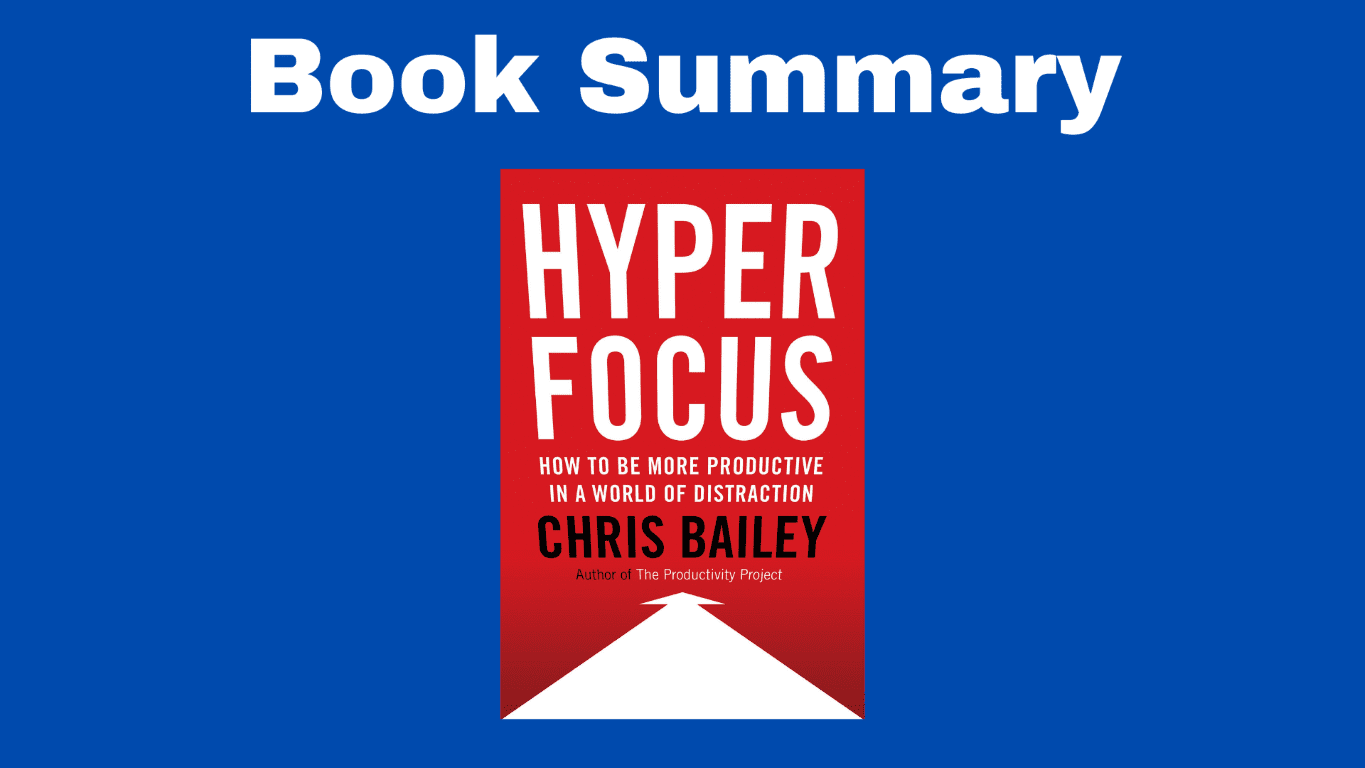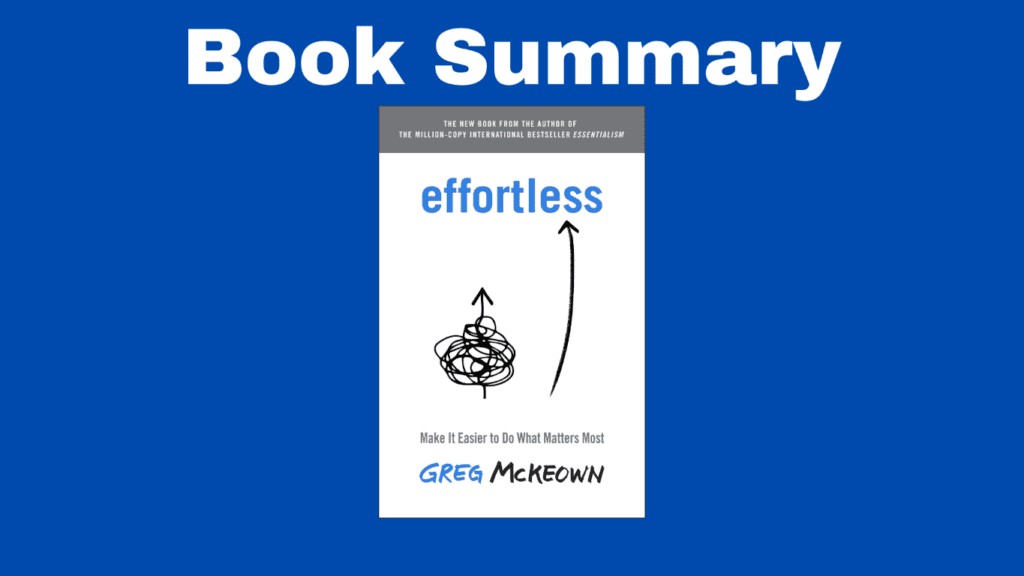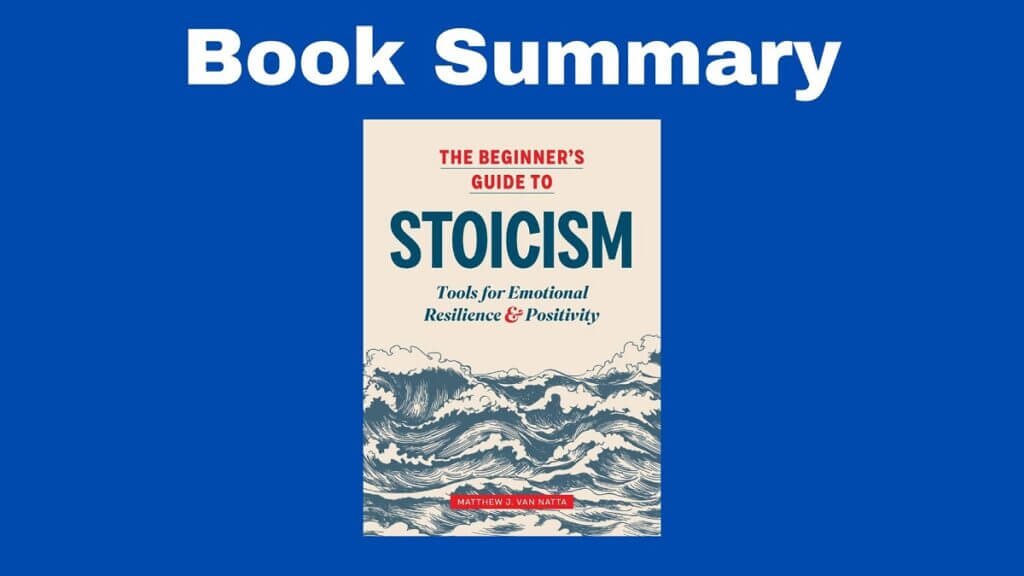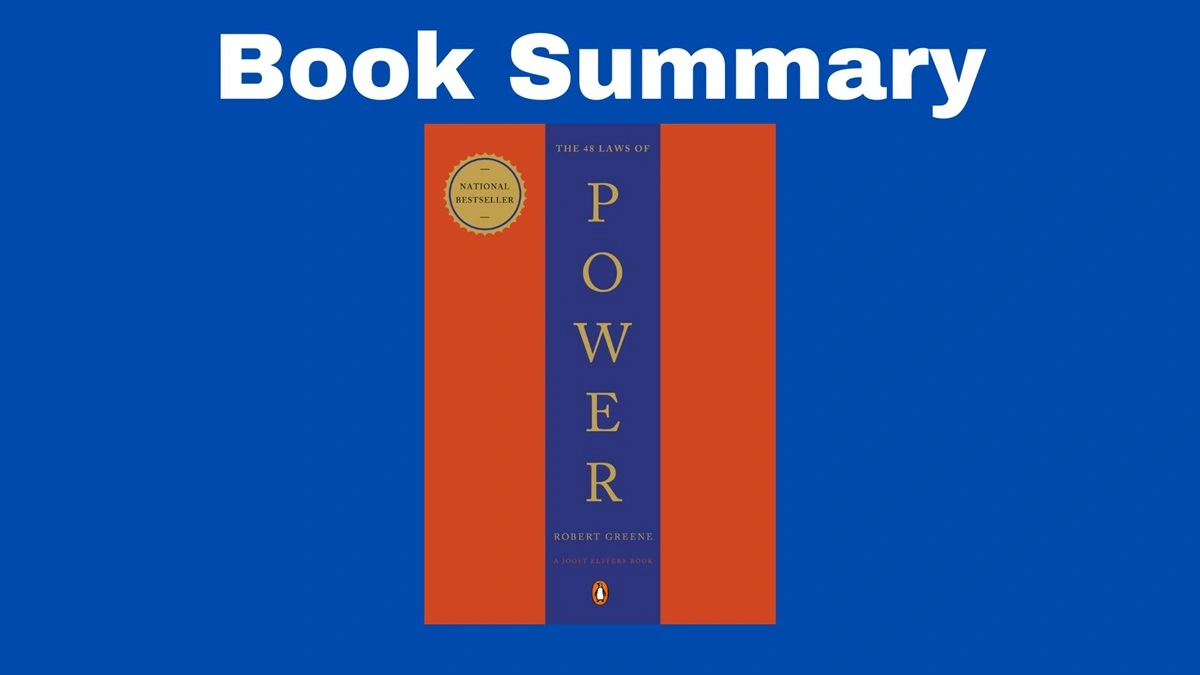The Book in Three Sentences
In this book summary of Hyperfocus, author Chris Bailey details the potential and the limits of focusing your attention on a single, meaningful task to be more productive. The book teaches you when you should be more productive and when you should be more creative. There are entire chapters dedicated to limiting distractions, recharging your energy, and consuming valuable information.
Hyperfocus Summary
Chapter 0: Why Focus Matters
Attention is all around us. We’re busy, but without accomplishing anything meaningful. We work 40 seconds on our computers before we’re distracted or interrupted.
Chapter 0.5: How to Better Focus on This Book
- Put your phone out of sight. When the mind resists a task, it looks for something new, such as a phone. The author describes your phone as a “productivity black hole” in your pocket. We instinctively pull our phones without noticing and without addressing our feelings.
- Mind your environment. You should find a focus-conducing environment where distractions are kept at a minimum.
- Make a distraction list. Write every distraction (both internal and external) in order to refocus.
- Questions whether this book is worth consuming or not. Don’t consume out of habit. Ask yourself: will I be happy after investing time and attention in this podcast, game, show, movie, or book? Bring awareness to your consumption habits, this can provide extra hours each day.
- Consume caffeine before reading. Caffeine gives a focus boost, but make sure you consume it early rather than late since it takes 8 to 14 hours to metabolize out of your system.
- Grab a pen or highlighter. Highlighting and taking down notes turns a passive activity into an active one.
- When you notice your focus wavering… This is normal. Accept it, do something mindless, such as cleaning, washing dishes, or people watching and return to your reading with a fresh mind.
Part I: Hyperfocus
Chapter 1: Switching Off Autopilot Mode
Autopilot mode guides us through actions like choosing a book to read. As many as 40% of our actions are habits, but some decisions are worth making deliberately. One such decision is managing our attention.
We’re all subjected to interruptions, such as alerts, notifications, noises, and buzzes. Directing your attention toward the most important thing for you (and maintaining that attention) is the most consequential decision you can make. We are what we pay attention to.
The four types of tasks:
| UNATTRACTIVE | ATTRACTIVE | |
| PRODUCTIVE | Necessary Work | Purposeful work |
| UNPRODUCTIVE | Unnecessary work | Distracting work |
Chapter 2: The Limits of Your Attention
There’s a limit to the number of things we can focus on. After focusing, we can retain a small amount of information in our memory.
Mindless work should become a habit because productive work requires brainpower.
Tasks that need attentional space:
- Small habitual tasks (breathing while running)
- A task that requires focus combined with a habitual task (listening to a podcast while playing a game)
- One complex task (writing the first draft of a book)
Noticing that we are overwhelmed and being more selective when it comes to your attentional space is important. Simplify our attentional space and live more intentionally. A good way to do this is by writing down our worries so that we don’t forget them, but also so that we don’t have to deal with them right now.
Seeking novel stimuli releases dopamine. This is what happens when we use our phones, tablets or when you multitask on the computer. This makes us feel productive, but we’re actually anything but. Busyness doesn’t mean being productive. If we intend to do nothing and do it, that’s still being productive.
There is nothing wrong with multitasking, but there’s a difference between multitasking (focusing on more than one task at the same time) and shifting our attention (constantly moving our attentional spotlight).
As we allow more devices into our life, we remember less.
- Set intentions often
- Make the environment less distracting
- Overcome mental resistance to certain tasks
- Eliminate distractions
Ask yourself:
- How much of your time do you spend intentionally?
- How long can you hold your attention in one sitting?
- How long does your mind wander?
Chapter 3: The Power of Hyperfocus
Main characteristics of hyperfocus
- Deliberate
- Undistracted
- Quick to refocus
- Completely immersed in work
- It makes us happy
In hyperfocus, only one productive task consumes your attentional space.
There are four stages to hyperfocus:
- Focus
- Our mind wanders (this happens as long as we’re not distracted or interrupted)
- We notice our mind wandering
- We shift our focus back to our original object of attention
To hyperfocus we must:
- Choose a productive object of attention
- Eliminate as many distractions (both internal and external) as possible
- Focus
- Bring your focus back when your mind wanders
Our mind wanders for 47% of the day.
Intention should always precede attention.
Daily intention rituals
- The rule of three: at the start of each day, choose the three things you want to have accomplished by the end of the day. Keep the list where you can see it.
- Your most consequential tasks: consider the long-term and short-term consequences of carrying out each task on your to-do list. How will your life change if you choose one task over another?
- The hourly awareness chime: set an hourly chime on your phone. Ask yourself the following questions. Was your mind wondering? Are you on autopilot or working intentionally? Are you part of a productive task? What’s the most consequential activity you could be doing? Are there distractions?
Setting specific intentions can double or triple your odds of success, but you have to care about your intentions.
How to go into hyperfocus:
- Set the amount of time (start with 15 minutes and increase over time)
- Anticipate obstacles
- Set a timer
- Hyperfocus
When to hyperfocus
- Whenever you can
- Around the constraints of your work
- When you need to work on a complex task
- Based on how averse you are to what you intend to accomplish
Chapter 4: Taming Distractions
We switch between computer applications 566 times on an average workday. In the author’s words, “Once you become aware of how frequently you interrupt yourself, it’s hard to go back to working the same way again.” Sadly, distractions are more enticing than work. Since we know this to be a problem, we should be better at managing impulses ahead of time.
The author describes a distraction as anything that “directs us away from our intentions.”
There are four types of distractions:
| ANNOYING | FUN | |
| NO CONTROL | Meetings, loud colleagues | Calls from loved ones |
| CONTROL | Email, phone alerts | News websites, social media |
It’s worse to interrupt ourselves than to allow others to interrupt us. Don’t worry about what you can’t control. It’s a waste of time, energy, and attention. So how do you deal with the distractions detailed in the table above?
| ANNOYING | FUN | |
| NO CONTROL | Deal with it! Get back on track. | Enjoy! |
| CONTROL | Deal with it ahead of time | Deal with it ahead of time |
“By removing every object of attention that’s potentially more stimulating and attractive than what you intend to do, you give your brain no choice but to work on that task.“
So taking distractions into account, when you try to hyperfocus, you should:
- Launch a distraction-blocking app on your computer. Establish a block list and set a specific amount of time. Put your PC in “do not disturb” mode.
- Put the phone in “do not disturb” mode. Keep it out of sight.
- Grab a coffee if you’re not going to bed for the next 10 hours.
- Put on noise-canceling headphones.
Also consider:
- Turning off Wi-Fi
- Getting out of the office
- Be thoughtful to others
- Treat yourself
The most common distractions include notifications, smartphones, email, meetings, and the internet, among others.
Smartphones and other internet-connection devices are some of the most distracting parts of our lives. Here are some tips to deal with them:
- Avoid using your phone while waiting in line, use those moments to recharge
- Strategically use airplane mode
- Consider having a second “distraction” device
- Create “mindless” folder
- Prune your list of apps
Pre-decide when you read email.
Never attend a meeting without an agenda
Regarding the internet, try going offline and see how your productivity changes.
Keep distractions 20 seconds away from you. This generates space between impulse and action.
Modify your environment to eliminate distractions:
- Take stock of the distractions around you
- Distance yourself
- Introduce productive cues
When you bring a new device into your life, question its value (or lack thereof). Every product we buy should do a “job” for us.
Chapter 5: Making Hyperfocus a Habit
Our mind wanders when:
- We’re stressed or bored
- We’re working in chaos
- We’re thinking of personal concerns
- We’re questioning our meaningful task
To increase attentional space just meditate for a few minutes each day. Focus on your breath.
Starting provides enough momentum to carry out our intentions.
To battle resistance:
- Minimize the amount of time you focus on a task
- Notice when you “don’t have time” for something
- Continually practice hyperfocus
- Recharge
Part II: Scatterfocus
Chapter 6: Your Brain’s Hidden Creative Mode
Daydreaming can destroy our productivity but allows us to solve problems creatively. Brainstorm and recharge.
Hyperfocus is all about productivity
Scatterfocus is all about creativity.
When our mind wanders it goes to one of three places: past, present, and future. We think more about the future than past and present combined.
Our mind wanders in one of two ways: intentionally and unintentionally. Scatterfocus is always intentional.
Styles of scatterfocus:
- Capture mode: your mind roams freely and capture what comes up
- Problem-crunching mode: thinking about a problem and letting your mind wander around it.
- Habitual mode: engage in a single task and capture the valuable ideas. This is the most powerful of the three modes.
In hyperfocus, you direct your attention outward. In scatterfocus, you direct your attention inward.
Chapter 7: Recharging Your Attention
Scatterfocus lets you recharge mental energy. Hyperfocus can be mentally tiring.
Signs that you’re mentally tired:
- You can’t focus on one thing
- Losing grips on intentions
- You’re slow to complete tasks
- Opting to do mindless work
- Unintentionally entering scatterfocus
Doing the work you love is less exhausting than doing the work you don’t care about.
A refreshing work break should be:
- Low-effort and habitual
- Something you want to do
- Something that isn’t a chore for you
Some examples of breaks include:
- Listening to podcasts, music or audiobooks
- Doing physical activities
- Meditating
- Reading something fun
- Spending time with people you like
- Doing a creative hobby (such as painting, or photography)
Rules for breaks:
- Take one break at least every 90 minutes
- Break for 15 minutes for every hour of work
About sleep:
For every hour of sleep you miss, you lose two hours of productivity the next day.
When we get less sleep we:
- Feel more pressure at work
- Focus for a shorter period
- Use social media more often
- Seek less demanding tasks
- Spend more time online
Habits like reading, meditating, drinking herbal tea, disconnecting, or getting rid of the TV, let you unwind and increase the quality of your sleep. Also, it’s important to get to bed at a decent hour.
Chapter 8: Connecting Dots
Our brain is a constellation of dots. With new experiences, we add more dots. In scatterfocus, we naturally connect the dots we’ve collected.
Collecting even more dots:
- Scatter your attention in a richer environment (walk through a bookstore, go people watching).
- Write the problems you’re trying to solve
- Sleep on a problem
- Step back
- Intentionally leave tasks unfinished
- Consume more valuable dots
Chapter 9: Collecting Dots
The more valuable the dots, the more we have to connect. We are what we pay attention to.
No two pieces of information are created equal. We should try to find information that’s both useful and entertaining, such as non-fiction books, online courses, and journal entries. Books, for example, take less than 10 hours to read, but decades to write. “Books provide access to the highest-quality thinking and most useful dots”. Then you have balanced dots which are less useful and entertaining. These include novels, podcasts, documentaries, and TED Talks. Finally, you have dots that are purely entertaining or just trashy, These are TV shows, mindless books, and social media.
The author encourages readers to think about the dots they consume and complete a chart that looks like this:
| USEFUL | BALANCED | ENTERTAINING | TRASHY |
- Consume things you care about, especially when few others do. Develop the skills and knowledge that you find entertaining. Use the medium you prefer: physical books, audiobooks, TED talks, and so on.
- Eliminate the trash. When you stop consuming trash, you make room for something that adds value to your life.
- Choose a few valuable things to add. Add something of value for each thing you eliminate.
- Notice when you consume on autopilot mode.
- Veg out… intentionally.
- Reevaluate what you’re consuming as you’re consuming it. Assess if what you started is worth pursuing to the end.
- Get things to bid for your attention. “See the descriptions of podcasts, shows, movies, and books as a pitch for your time and attention.”
- In the moment, zoom out.
- Invest in serendipity. As the author puts it: “Consume challenging things outside the boundaries of your expertise.” Let yourself try something new you know nothing about.
- Double down on what’s valuable
Here are some tips to scatterfocus:
- Disconnect the internet between 8PM and 8AM.
- When you finish a task, scatter your attention.
- Use an alarm clock instead of a phone
- Go places with only a notepad
- Take longer showers
- Make yourself bored
- Simplify your environment
- Cook with music instead of the TV
- Go for a walk
- Visit a gallery
- Work out without music
Chapter 10: Working Together
Invest in your own happiness. A positive mood increases the size of your attentional space and a negative mood shrinks it.
These are the top five activities that make people the happiest:
- Listening to music
- Playing
- Talking and investing in relationships
- Exercising
- Making love
You can try to:
- Recall three things you’re grateful for at the beginning and end of each day
- Journaling at the end of each day
- Meditating
- Doing random acts of kindness
Caffeine deepens our focus, helps us persevere, and improves our performance.
Further Reading
If you liked this summary of Hyperfocus, you should also read:




